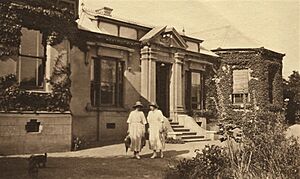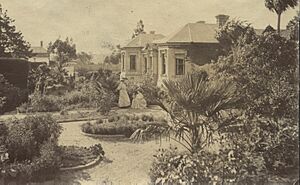- This page was last modified on 17 October 2025, at 10:18. Suggest an edit.
Buda Historic Home & Garden facts for kids
| Buda Historic Home and Garden | |
|---|---|
| Delhi Villa | |
| Lua error in Module:Location_map at line 420: attempt to index field 'wikibase' (a nil value). | |
| Type | Villa, associated built facilities and gardens |
| Location | 42–48 Hunter Street Castlemaine, Victoria |
| Nearest city | Bendigo |
| Area | 1.2 Ha |
| Built | 1857-1861 |
| Built for | Reverend James Smith and family |
| Restored | 1890 |
| Restored by | Ernest Leviny |
| Architectural style(s) | Italianate |
| Visitors | 5942 (in 2019–20 excluding COVID restricted period) |
| Governing body | Buda Historic Home and Garden Incorporated |
| Owner | Trustees of the Castlemaine Art Gallery and Historic Museum (CAGHM) |
| Website | https://budacastlemaine.org |
| Official name: Buda Historic Home and Garden | |
| Type | Registered Place |
| Designated | 21 March 1978 |
| Reference no. | VHR H0134 |
Buda is a special old house and garden in Castlemaine, Victoria, Australia. It's listed as a heritage site, meaning it's important to history. In 1970, the Castlemaine Art Museum bought Buda to look after it.
Since 1981, Buda has been open to visitors almost every day, from 12 PM to 4 PM. It's a great place to explore and learn about the past.
Contents
The Historic Buda House
Buda house was built between 1857 and 1861. It was designed in the Italianate style, which was popular at the time.
Delhi Villa: The First Name
A retired missionary named Reverend James Smith built the house in 1861. He called it Delhi Villa. He planned a six-room brick house with a verandah all around it. He thought this style, like Indian bungalows, would be perfect for Australia's climate. However, after only two years, Smith decided to go back to India for his missionary work. The house was then put up for sale.
Ernest Leviny's New Home
In 1863, a successful businessman and jeweller named Ernest Leviny bought the property. He bought it to be the home for himself and his second wife, Bertha Hudson, whom he married the next year. They raised their ten children in this house.
Ernest Leviny made many changes to the house and its grounds, especially between 1890 and 1900. Around this time, the house was renamed Buda. It was named after the city of Budapest, which is the capital of Hungary, Ernest Leviny's home country.
The Beautiful Buda Garden
Buda house sits high above the town, offering amazing views to the south and southwest. The property covers 1.2 hectares (about 3 acres) of beautiful, old gardens. A famous botanist, Baron Ferdinand von Mueller, visited the house while he was designing the Castlemaine Botanical Gardens. People believe he influenced the design of Buda's garden and even gave the family some of its largest trees.
Buda's garden is one of the most important 19th and early 20th-century gardens still existing in Victoria. It's special because of how it's divided into different sections, how well it's been kept, and because it still has two important old garden buildings: an aviary (for birds) and a former tennis pavilion.
In 1984, after Buda had been open to the public for three years, the gardens were restored. This work was funded by the Victorian government to celebrate the state's 150th anniversary. A group called "Friends of Buda" also helped with the restoration.
In 2011, a large cypress hedge that was a main feature of the garden had to be removed because it was dying. This allowed the original view from the house to be seen again. Twelve new trees were planted to replace the hedge.
The Leviny Family
The house is filled with amazing artworks and items made by Ernest and his daughters. These include jewellery, enamelwork, decorated fabrics, woodwork, and photographs. One of the daughters even decorated the ceiling border in one of the bedrooms!
Ernest Leviny's Life
Ernest Leviny was born in Hungary in 1818. He trained to be a silversmith and jeweller in Budapest. He arrived in Melbourne, Australia, in early 1853 and went straight to the goldfields near Castlemaine. There, he started a very successful business making watches and jewellery. By 1863, he was able to retire from his business and buy Delhi Villa. In 1864, he married Bertha Hudson and they settled in Castlemaine.
The Creative Leviny Children
Ernest and Bertha had ten children between 1865 and 1883: four sons and six daughters. Sadly, two of their sons died when they were very young. The Leviny daughters were encouraged to follow their artistic interests. This was a time when women were starting to have more chances to study art and have careers. They worked with many different materials, including painting, woodcarving, metalwork, photography, and needlework. Their mother, Bertha, was also skilled at making clothes by hand, which inspired them.
Each of the daughters was creative in her own way:
- Mary, the oldest, helped a lot with running the house. She also made many of the family's clothes and was skilled at embroidery and decorating.
- Hilda was an expert in embroidery. Some of her work was shown in a special exhibition in 1907. One of her pieces, a three-panel screen with hand-embroidered designs, is still on display at Buda.
- Gertrude focused on woodcarving.
- Kate was a talented photographer.
- Dorothy won awards for her fine art and photography. She was especially good at metal and enamel work.
Buda's Lasting Legacy
After Ernest's death in 1905, his daughters adopted the British Arts and Crafts style. They used this style to decorate the house, including the furniture, colours, handmade items, metal light fittings, and embroidered soft furnishings. Most of these items were made by the Leviny women themselves.
The last surviving sister, Hilda, made sure Buda would be preserved. In 1970, she sold the property to the Trustees of the Castlemaine Art Gallery and Historic Museum. This made sure Buda would become a house and garden museum for everyone to enjoy.
Buda Today
The Leviny family lived in the house for 118 years, from 1863 to 1981. When Hilda, the last surviving daughter, passed away at 98 years old, the house and garden were opened to the public. It is still a popular place for tourists and is a major location during the bi-annual Castlemaine State Festivals.
Since opening to the public, Buda has been looked after by many amazing volunteers from the local community. They help with everything from gardening and maintenance to managing historical records and giving tours.
Buda still looks like Ernest Leviny's idea of a "gentleman's villa." It has its Italianate style and the "parsley" green trims and shutters, which were common in country homes from Ernest Leviny's European background.
Buda has received grants from the Victorian state government to help with its upkeep. For example, in 2018–2019, they received money for irrigation, trees, and paths. In 2019–2020, they received funds for building repairs.
Displays and Exhibitions
Buda often has special displays and exhibitions that show off its collections and history.
- 1984: Tableau of 18th Century Dress, a display of 18th-century clothing.
- 1987: Sketches and paintings by Ernest Leviny and his daughters were shown.
- 2005: The Contemporary Australian Silver & Metalwork Award exhibition was held.
- 2018: A special Textiles Exhibition took place.



